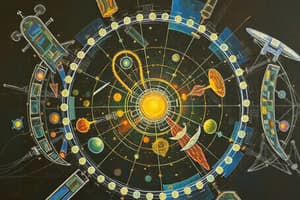Podcast
Questions and Answers
Which of the following statements about ideal gases is true?
Which of the following statements about ideal gases is true?
- Ideal gas molecules occupy a volume in space and have inelastic collisions
- Ideal gas molecules have high densities
- Ideal gas molecules exhibit strong intermolecular forces
- Ideal gas molecules have no intermolecular attraction and collide elastically (correct)
What is a key similarity between ideal and real gases?
What is a key similarity between ideal and real gases?
- Real gas particles have infinitesimal size
- Ideal gas particles have attractive intermolecular forces
- Gas particles are at constant random motion (correct)
- Real gas particles have no intermolecular forces
What does the ideal gas law describe the relationship between?
What does the ideal gas law describe the relationship between?
- Pressure, temperature, number of moles, and volume (correct)
- Temperature, volume, and intermolecular forces
- Pressure, temperature, and density
- Volume, number of moles, and density
How do real gas molecules differ from ideal gas molecules?
How do real gas molecules differ from ideal gas molecules?
What type of collisions do ideal gas molecules experience?
What type of collisions do ideal gas molecules experience?
What does the behavior of real gases help extrapolate?
What does the behavior of real gases help extrapolate?
What is the main reason the ideal gas law fails at high pressures and low temperatures?
What is the main reason the ideal gas law fails at high pressures and low temperatures?
Which equation describes real gas behavior by considering intermolecular forces and molecular size?
Which equation describes real gas behavior by considering intermolecular forces and molecular size?
What are the correction constants in the Van der Waals Equation used for?
What are the correction constants in the Van der Waals Equation used for?
What does the Van der Waals Equation include parameters for?
What does the Van der Waals Equation include parameters for?
What are the correction constants (a and b) in the Van der Waals Equation for ideal gases?
What are the correction constants (a and b) in the Van der Waals Equation for ideal gases?
What is the key concept in gas physics that represents the force exerted by gas molecules on their container walls?
What is the key concept in gas physics that represents the force exerted by gas molecules on their container walls?
What causes marshmallows to expand when air is removed from a jar?
What causes marshmallows to expand when air is removed from a jar?
What is the composition of atoms?
What is the composition of atoms?
What defines an atom's atomic number?
What defines an atom's atomic number?
What are isotopes?
What are isotopes?
What does the periodic table organize elements by?
What does the periodic table organize elements by?
What is the charge of electrons?
What is the charge of electrons?
What is the mass of protons?
What is the mass of protons?
What law states that volume and temperature are directly proportional at constant pressure?
What law states that volume and temperature are directly proportional at constant pressure?
Study Notes
Atom Structure and Properties
- Removing air from a jar causes marshmallows to expand due to Boyle's Law, which states that pressure and volume are inversely proportional at constant temperature.
- Heating a marshmallow causes expansion due to Charles' Law, which states that volume and temperature are directly proportional at constant pressure.
- Atoms are the smallest units of matter, composed of subatomic particles, and elements consist of only one type of atom.
- There are 118 natural and synthetic elements, with atoms measuring about 10-10 meters.
- Atoms have an internal structure and are made of subatomic particles: protons, electrons, and neutrons.
- Protons are positively charged, have a mass of about one atomic mass unit (amu), and define an atom's atomic number.
- Electrons have a negative charge and participate in chemical reactions, forming ionic or covalent bonds.
- Neutrons are located in the nucleus with protons, have no charge, and contribute to the atomic mass.
- Isotopes are atoms with a different number of neutrons, some of which are stable, while others undergo radioactive decay.
- The periodic table organizes elements by their physical and chemical properties, based on their atomic number and atomic mass.
- The atomic number, element abbreviation, and atomic mass in amu are shown for each element in the periodic table.
- Understanding the behavior of atoms and their subatomic particles is crucial for comprehending their properties and interactions in chemical reactions.
Studying That Suits You
Use AI to generate personalized quizzes and flashcards to suit your learning preferences.
Description
Test your knowledge of atom structure and properties with this quiz. Explore Boyle's Law, Charles' Law, the composition of atoms, subatomic particles, isotopes, and the periodic table. Gain insights into the behavior and interactions of atoms in chemical reactions.




